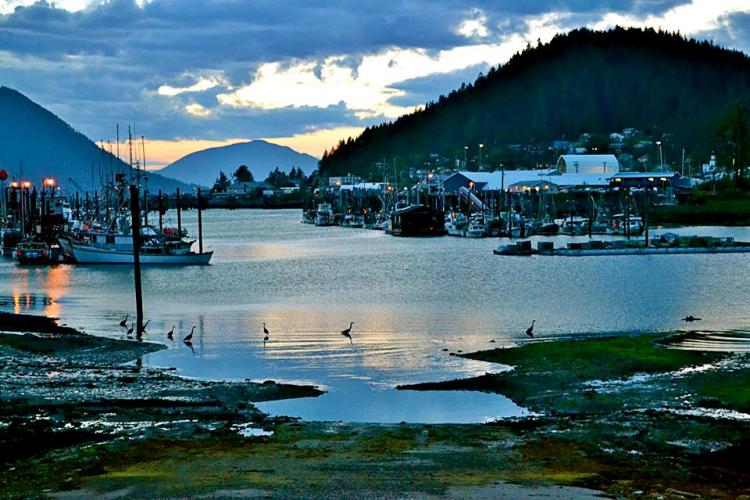
Sitka Alaska.
I returned to Sitka with my last vessel on a Thursday. It looked like I might be waiting for a few days before my next deployment. A day or two is always nice to have after each assignment—enough time to finish up paperwork, wash clothes if need be, and maybe fit a little hike in if the opportunity (and weather) allows. However, I started to become a little worried that those couple days could extend for another three or four.
With no trips in sight, I found out that on Friday I would be heading back to Seattle on Sunday—at least a trip or two earlier than I had anticipated. Alas, that is the life of an observer: plan for one thing and then you are handed a completely different game plan. Well, that is exactly what happened to me an hour before I left my hotel for the airport on Sunday. I wouldn’t be heading home after all.
Observers were needed for several trips in southeast, and now there was a tight crunch to deliver them. I ended up staying one more night in Sitka before flying to Wrangell the next day. With all my personal and sample gear in tow, I flew from Sitka to Juneau, then boarded another plane for the milk run down to Sitka.
But weather delayed the trip. So what to do with my spare time? Go see some petroglyphs of course!

Petroglyphs found on beach.
Petroglyph beach was just a short (rainy) walk from the Stikine Inn. I timed it to arrive at the beach during low tide and was able to find the large cluster of engravings. For my first time in Wrangell I was glad I was able to take the time to see them. Many of them are fairly worn from wave action, but nevertheless were truly remarkable given they could be thousands of years old.
After checking out the petroglyphs I headed over to conduct the safety checklist with my boat. The plan was still to sail early the next morning, but later that evening the captain texted to ask if I could leave that night instead. The weather had significantly improved during the day and it would be a very pleasant evening to head out.
Luckily, I was pretty much packed when he contacted me (I do live out of a bag after all). Since my sampling gear was already on the boat, I made a quick trip down to the transient dock for the boat to swing by to grab me on their way out of the harbor.
This 46-foot vessel would be fishing for all of their halibut quota this trip. The boat uses “stuck” longline gear (longline gear with hooks permanently attached) and planned to be setting by the next morning, after about an eight-hour jog to the fishing grounds.

The weather was indeed surreal, nearly glass-like waters and the sun was preparing for a picturesque dusk. While two of the crew baited on deck, I chatted with the captain as we headed out. They were all locals from Ketchikan. Two of them were commercial divers for sea cucumbers and geoducks. There are only 55 commercial geoduck divers in the entire world, and two of them were on this boat! I was full of questions, having scuba dived myself in the past. Like many other halibut trips I’ve been on, this vessel also seined for salmon. Most of these halibut boats have a hand in the state-managed commercial salmon fishery.
The crew set their first string in the morning and anticipated making another two sets that evening. I prepared deck forms for all three sets and collected measurements to use as a reference for estimating halibut lengths. This was the second vessel I had ever observed on that hauled gear port side. I hadn’t realized why the first time, but it was because the roller man (who is also the captain) is left handed.
On just the first day, they made a dent in their quota, but with more foul weather predicted for the next couple days, the crew planned to hunker down at a safe anchor spot. Over the next couple of days, the crew baited and waited to see what the weather would do outside the bay. I spent time cleaning up my data forms, filling in my logbook where I could, and read one of the many saved books on my e-reader (and caught up on my blog of course!).
Once the crew had a weather window of opportunity, more gear was set and we headed into the small boardwalk port of Point Baker to tie up for the storm they knew would be blowing through that evening.
The locals run sport fishing lodges that I was told are frequented by people from across the United States. A group had just left from North Carolina. Little did I know that around the corner, the Discovery Channel’s reality show “Port Protection” was taping on location.
We left Point Baker late morning for the crew to haul gear. Everyone was anxious to end the trip with a bang. Unfortunately, it was still not quite enough to call it quits. It would be another couple sets until the crew caught their fill. They delivered later that same day and I disembarked from the vessel. I returned to Seattle the next day to begin the debriefing process.
Three weeks and three boats made for an enjoyable short deployment. Although I can generally expect a certain number of boats, plans and ports are never certain and the pace of each is even more variable because we have to be ready to go where observers are needed. I could be given a two-day notice or two-hour notice, so I must be prepared for all circumstances. However erratic my schedule may seem, I am able to find time to balance rigorous work and moving around with physical activities in the tranquil surroundings of Alaska.




